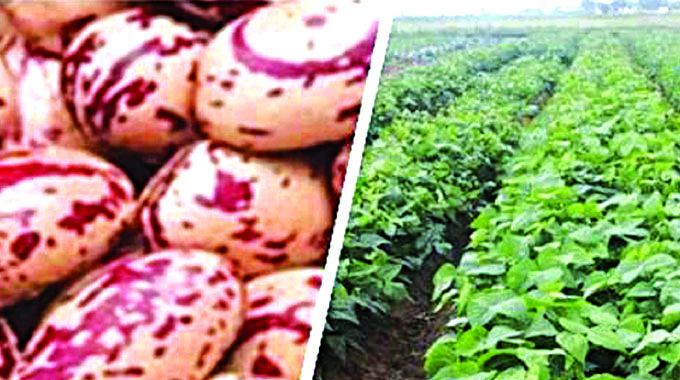
AS we start the month of February, farmers should appreciate that the time to plant the traditional maize and soyabean crop is now long over. Any farmer who is still eager to plant something should now think in terms of planting filler crops like sugar beans and sweet potatoes.
Sugar beans
Sugar beans prefer well drained soils and, therefore, farmers should take note and avoid wet places to plant sugar beans.
The optimum pH level for sugar beans is 5,8, therefore if you have been growing maize on the same plot, it would help to have the soil analysed for pH level, for maize fields normally receive a lot of fertilisers and risk having their pH levels high.
One requires 80 to 100kg of seed per hectare depending on variety (approximately 40kg per acre).
The SC Bounty requires 80-100kg per hectare, while the speckled type requires 100kg per hectare.
Unless planting into moist soil, one should never place sugar bean seed and fertiliser together at planting. Sugar beans should be planted to a depth of only 2,5cm, some farmers make mistake of planting them like they are planting maize.
The spacing should be 40cm between the rows and 7cm inside the row. If properly fertilised and managed, sugar beans will grow very vigorous and cover the ground spaces in between.
Sugar beans require a basal fertiliser of 300kg of Compound D fertiliser and, therefore, you can use all your basal fertiliser remaining from the maize on the sugar beans.
Sugar beans are not very good at fixing nitrogen like other leguminous crops and therefore, farmers can inoculate the seed with rhizobium at planting or apply some top dressing of 100kg per hectare about 21 days after planting to boost them. Split applying the top-dressing application will definitely achieve better results.
The most notorious pest of sugar beans is bean stem maggot, which will create some mining tracks on the leaves. Sugar beans take about three months to reach maturity, and another month to dry. Expected yield level is 1,5 to three tonnes per hectare, depending on variety.
Sweet potatoes
Sweet potatoes are popular as a filler crop, especially with smallholder farmers. They are largely eaten as boiled at breakfast. Sweet potatoes are usually planted on raised ridges, 30-45cm high and 75-90cm wide.
The raised beds provide the crop with loose soil that is essential for root development and tuber development.
The ridges prevent deformed tubers and makes harvesting easier. It is best to prepare the ridges along the contour so that water will continue to flow uninterrupted.
The quality of cuttings to use at transplanting has always been guesswork. Farmers are urged to use well established, healthy freshly cut plants.
There is a tendency by some farmers to buy the cuttings, and spend days before they are transplanted, that should be discouraged.
When planting, make sure at least three nodes have been placed below ground level, but the more nodes covered underground the better, the yield. Cuttings should ideally be 30 to 40cm long.
As much as possible, cuttings should be planted at 45-degree angles, to promote sprouting. A spacing of 30-40cm between plants is recommended. Farmers should aim to achieve 30 000 cuttings per hectare.
Cuttings should be planted 6cm deep, planting cuttings too deep, will make it difficult for the cuttings to sprout and also makes harvesting difficult later.
The best time to plant sweet potatoes is when there are rainy conditions, obviously, they will establish quicker. During the first two weeks after planting, the planted ridges should be monitored and any dying plants replaced.
Most farmers are used to growing sweet potatoes without fertiliser, believing that they are a scavenger crop.
Sweet potatoes are actually heavy feeders and a fertilised crop will yield better than a non-fertilised crop. Compound D can be applied at the rate of one kilogramme per square metre. This works out to between 600-900kg per hectare.
The use of cattle manure, especially not well composted ones, should be avoided. Too much nitrogen, released by the decomposing cattle manure will encourage vigorous leaf development, but no tubers.
About 100kg per hectare of top-dressing fertiliser especially on sandy soils, applied at flowering, will also produce a better crop, however, too much AN affects the taste of the sweet potatoes, therefore the best is to have your soils tested for fertiliser recommendations.
It is best not to grow sweet potatoes on the same piece of land, once every three years is recommended.
Growing sweet potatoes on the same piece of land means vines from the previous crop will emerge and these might prevent nodulation on fixing nitrogen by the crop.
